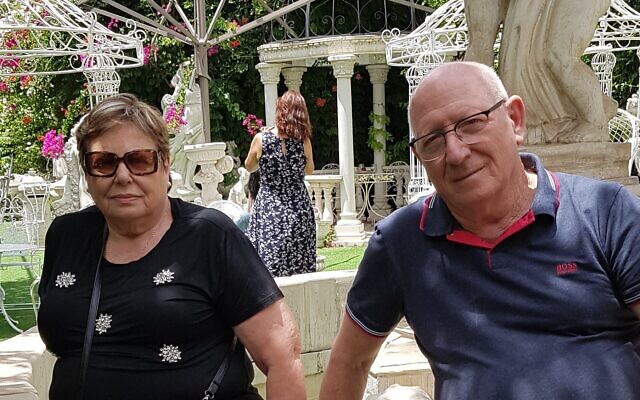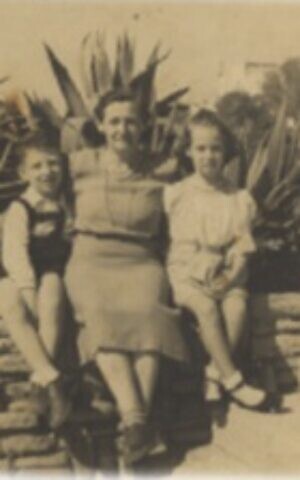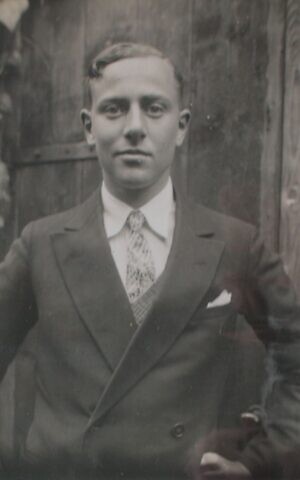MANTUA, Italy — When David Reicher was three months old, his father left the house and never came back. Now, after 76 years, Reicher, an Israeli citizen born in Italy in 1943, has finally learned his father’s fate.
Marian Reicher, a Polish Jew, was among the 335 civilians murdered in the Fosse Ardeatine massacre on March 24, 1944. The indiscriminate mass killings, which targeted Jews and Gentiles of all ages, from all professions, and socioeconomic groups, were carried out by the Nazis as a reprisal for a partisan bomb attack on an SS regiment the day before which killed 33 SS police.
Marian was among the eight victims of the massacre that until recently had still not been identified. But in April of this year, Reicher received a phone call from an army general in charge of the General Commissariat for Honors to the Fallen, an agency serving directly under the Defense Minister. Reicher’s DNA, it was revealed, matched one of the unidentified victims buried in the Fosse Ardeatine quarries, where the group had been shot point blank, execution-style, to save ammunition.
Finally knowing what happened to his father was a great relief for Reicher.
“It was a very happy day for me,” Reicher told The Times of Israel. “I’m sorry that my mother and sister, who died years ago, could not know my father’s fate.”

David Reicher with his wife, Rebecca, June 2020. (Courtesy)
The identification was made thanks to the forensic investigations unit of the Carabinieri military police. In 2009, the unit archived biological data from the unidentified victims’ remains to be later compared with samples from surviving family members.
“It’s very important for Holocaust survivors to know what happened to their relatives,” said Reicher. “Maybe some of them may still be alive, [and] every year on the day of a deceased relative’s death, Jews light a candle in their memory.
“Not knowing the date of my father’s death, I used to light a candle on Holocaust Remembrance Day. Now I know the exact date when I can honor him,” said Reicher.

335 were murdered by the Nazis in unused quarries in the Fosse Adreatine massacre in 1944. (Italian Defense Ministry)
Murder by quota
For their massacre, the Nazis first selected Italian prisoners already slated for execution. When that wasn’t enough — they had decided on 10 reprisal murders for each SS man killed — they expanded their criteria to include others imprisoned for long sentences or serious crimes.

A shrine to the 335 murdered by the Nazis in the Fosse Adreatine massacre in 1944. (Italian Defense Ministry)
They finally filled the quota by adding Jews in Nazi custody who were waiting to be deported from Italy by way of the Fossoli concentration camp near Modena. In all, 76 Jews were killed; it was the largest massacre of Jews in Italy during the Holocaust.
After the war, the Fosse Ardeatine — a group of unused ancient quarries located near the Via Ardeatina — were transformed into a shrine and national monument.
Reicher’s family had gone to great lengths to find out what happened to Marian. His wife’s cousin took a genealogy course and searched online, as well as in the archives of the Italian Red Cross and the International Tracing Service in Bad Arolsen, Germany. The family acquired other documents from Yad Vashem, Israel’s national Holocaust memorial and museum.
“My father was deported to a field near Bassano del Grappa in northern Italy on January 20, 1944,” Reicher said. “The Santa Croce detention camp was mentioned in another document dating back to November 1944. My name appears on that list next to the names of my mother and my sister Rosetta, but there is no reference to my father.”

David Reicher, left, with his mother Ethel and sister Rosetta after the war. (Courtesy)
Reicher had believed his father was killed in the Fosse Ardeatine massacre, but he hadn’t been sure.The DNA test confirmed his suspicions.
Marian Reicher, was born in 1901 in the town of Kolomyia, which was then Poland but now located in modern-day Ukraine. He became a dentist and married Ethel Lachs. The two fled to Italy during WWII.
“My parents arrived at the Enego camp near Vicenza on November 25, 1941,” Reicher said. “My sister was born on January 8, 1942, in Bassano del Grappa. My mother was very young when she became a widow with two children to take care of. It was a trauma, she never wanted to talk about it.”
In 1945 the surviving family moved to Israel, settling in Tel Aviv. Reicher got married, had three children, and now has eight grandchildren and three great-grandchildren.
Hi-tech investigation confirms two more victims
Reicher recently contacted the Mausoleum of the Fosse Ardeatine and spoke with Col. Roberto Esposito, an officer of the General Commissariat for Honors to the Fallen.

Heinz-Erich Tuchmann, killed in the Fosse Ardeatine massacre in 1944. (Courtesy Jeremy Tuckman)
“Some documents place Marian Reicher in Rome during the massacre period. We asked David to send us a swab with his DNA to compare it with victim’s DNA and so we came to the identification,” Esposito told The Times of Israel.
Recently, science and technology have helped identify another victim of the Fosse Ardeatine’s massacre. Heinz-Erich Tuchmann was a Jew from Magdebourg, Germany, who moved to Yugoslavia in 1930 for business and then to Italy. In this case, too, DNA played a crucial role. Tuchmann’s nephew, Jeremy Tuckman, who currently lives in England, provided a biological sample for comparison.
In the late 1940s, Tuckman’s father Frederick heard that his brother had been killed in the Fosse Ardeatine massacre, but the DNA test that could corroborate that information hadn’t been invented yet.
Recently, Italian researcher Michela Mecocci traced Tuchmann, who was on the list of victims yet to be officially identified, back to his living relatives while she was making a documentary on the massacre. Mecocci gave the General Commissariat the results of her research and put the officials in contact with Tuckman.

Jeremy Tuckman. (Courtesy)
“I wasn’t sure that my uncle was one of the victims of the massacre,” Tuckman told The Times of Israel. “I was very happy to receive this news, which represents the confirmation of what my father was looking for all his life. Identification through DNA testing has brought our family peace, happiness and relief for the conclusion of the quest. My uncle found dignity and recognition in death.”
When pandemic-related restrictions permit it, a public ceremony will be held, and attended by Reicher, Tuckman, their relatives, and Italian Defense Minister Lorenzo Guerini.
 RSS Feed
RSS Feed















 August 15th, 2020
August 15th, 2020  Awake Goy
Awake Goy  Posted in
Posted in  Tags:
Tags: 













